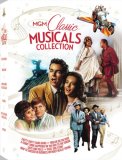| Reviews & Columns |
|
Reviews DVD TV on DVD Blu-ray 4K UHD International DVDs In Theaters Reviews by Studio Video Games Features Collector Series DVDs Easter Egg Database Interviews DVD Talk Radio Feature Articles Columns Anime Talk DVD Savant Horror DVDs The M.O.D. Squad Art House HD Talk Silent DVD
|
DVD Talk Forum |
|
|
| Resources |
|
DVD Price Search Customer Service #'s RCE Info Links |
|
Columns
|
|
|
MGM Classic Musicals Collection (West Side Story, Fiddler on the Roof, Guys and Dolls, Chitty Chitty Bang Bang, and more!)
M-G-M and 20th Century-Fox have gathered together six high-profile musicals and titled the collection, somewhat awkwardly, MGM Classic Musicals Collection. I say "awkwardly," because none of the films included in this set were actually produced by M-G-M (although Guys and Dolls was ultimately released by Metro). With a bargain grouping like MGM Classic Musicals Collections, the most critical consideration is what the transfers are like, and if there are any extra bonuses included that will make double-dipping an option. The transfers are quite good, with the exception of Guys and Dolls and How to Succeed in Business Without Really Trying, which are presented in sub-standard, flat letterboxed versions. As for bonuses, only trailers are present (West Side Story, however, doesn't even have that), except for Fiddler on the Roof, which has a commentary track by director Norman Jewison. Let's look at the individual films.
GUYS AND DOLLS
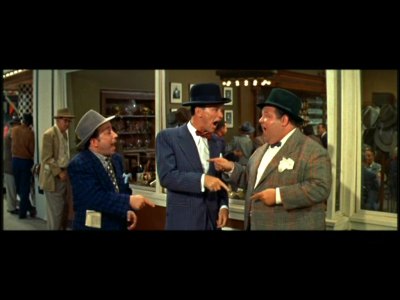
Based on the same-titled Broadway smash, with music and lyrics by Frank Loesser, book by Jo Swerling and Abe Burrows (based on the Damon Runyon short story, The Idyll of Miss Sarah Brown), Guys and Dolls celebrates the loveable sharpies and frauds who prowl Broadway in search of the next big score. Nathan Detroit (Frank Sinatra), known for running the "oldest established permanent floating crap game" in New York City, is in a jam. The cops, specifically Lt. Brannigan (Robert Keith), are breathing down his neck, aware that he's desperately trying to set up his next big game. Unable to raise the $1,000 scratch needed to secure the Biltmore Hotel's garage location, Nathan thinks he has a sure bet when he challenges Sky Masterson (Marlon Brando), a high-roller who just blew into town, to take any woman of his choosing for a night in Havana, Cuba. Sky agrees, and Nathan chooses Miss Sarah Brown (Jean Simmons), an uptight Salvation Army officer who runs a failing mission on Broadway.
Rebuffed initially, Sky preservers when he promises Sarah he'll stock her mission with bodies, which will save the mission from folding. They travel to Havana, and to both of their surprise, fall in love. Meanwhile, Nathan isn't so lucky on the love front, having had a final blow-up with his fiancé of fourteen years, Miss Adelaide (Vivian Blaine). Will Nathan have to pay up to Sky? And will Sky close the deal with Miss Sarah? Or will they both lose at the final big crap game, courtesy of heavy-duty gangster Big Jule's (B. S. Pully) cheating?
Try as I might, I've never been a fan of director Joseph L. Mankiewicz's big, lumbering, flat-footed version of the Loesser/Swerling/Burrows hit. Very few elements of the film work, with curious, downright counterproductive casting, unsuccessful art direction, mundane compositions, and an uptight, tense atmosphere that's all wrong for this supposedly big, brawling paean to the hustle and bustle of Broadway. Everyone discusses the miscasting of Brando and Sinatra (famously, they didn't get along off-camera, with Sinatra - ticked off that Brando, after On the Waterfront, had beaten him out of yet another plum movie role - calling Brando "Mumbles" and Brando calling Sinatra "Baldy"), and they are indeed, all wrong here. Brando, clearly out of his element in the singing department (his reed-thin delivery sounds like a scared kid during a high-school production), is no better in the acting department, taking the Sky character to too-cool heights, with a constant smirk on his face that either suggests Brando thought he was above the material, or he was trying to cover how terrified he was at how he might come out on screen. Sinatra, always good playing punks and losers and emotionally fragile characters, plays Nathan for bland, henpecked laughs, much like a sitcom dad from the 1950s, eliminating any of the juice and whining that makes the Nathan character so pathetic and funny in his endless hustling. With all apologies to DVD Savant, I've never been that keen on Jean Simmons, either, and her usual cold, brittle, closed-off reserve (just check out those dark, distant eyes in close-up) is on full display here. She's certainly believable as a prig of a missionary, but her sudden transformation to wanton drunk is forced and unconvincing.
Director Mankiewicz, never known for the most scintillating of camera set-ups (his mammoth epic, Cleopatra, is one of the most claustrophobic examples of the genre), can't do much to enliven the proceedings, frequently planting the camera at mid-level and trucking it along to follow the actors as they walk along the bizarre, stylized sets that feature a most unattractive bilious yellow and grimy green color scheme. The choreography by Michael Kidd is amusing, and of course, the actual songs by legend Frank Loesser are marvelous (when not being murdered by Brando and indifferently put over by Sinatra), but they pop up too infrequently in this bloated mess, with long, lugubrious dialogue scenes weighing down the proceedings, as characters endlessly negotiate with each other over romantic and economic concerns. Thank god Vivian Blaine shows up for several musical numbers. Her Take Back Your Mink is nicely realized, and the sexy, dirty Pet Me Poppa, added for the film by Loesser, is a real wow, with Blaine a flirty gangbuster (I particularly like how the Goldwyn Girls take their paws and wash their um...tails). But a few choice Blaine moments, along with the always marvelous Stubby Kaye and Johnny Silver popping in and out, can't rescue Guys and Dolls from its own miscalculations.
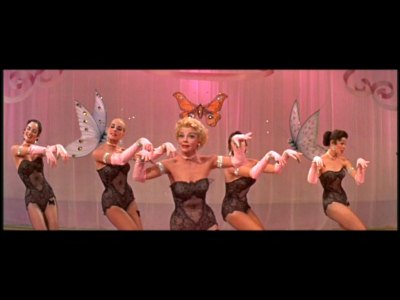
The DVD:
The Video:
The transfer used here for Guys and Dolls is the older, flat, non-anamorphic 2.55:1 letterboxed version that reproduces a fuzzy, grainy, soft picture. It's a shame they didn't go with the newer transfer, but it's not surprising considering this is a budget collection.
The Audio:
The Dolby Digital English 5.1 audio mix is attractively strong (with little rear speaker distribution, though); a Dolby 3.0 Surround mix is offered in both Spanish and French. French and Spanish subtitles are available, and close-captioning options are also included.
The Extras:
There are no extras included for Guys and Dolls.
Final Thoughts:
The memory of the sensational Frank Loesser songs give 1955's Guys and Dolls a coat of gilt it doesn't deserve, with the oddity of the casting (as well as the perfunctory performances) and the unconvincing production weighing down this supposedly brassy, ballsy tribute to the sharpies and frauds down on Broadway. A misfire on almost all fronts.
WEST SIDE STORY
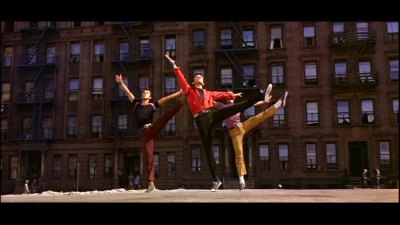
Perhaps more influential than "successful" during its initial run (it didn't win the Tony for Best Musical, nor did it have an exceptionally long run during its premiere engagement), I would suspect that when most people hear "West Side Story," they think of the film version that grossed millions and won ten Oscars, including Pest Picture. Based on the 1957 musical with music by Leonard Bernstein, lyrics by Stephen Sondheim, and a book by Arthur Laurents (with an obvious assist from Shakespeare's Romeo and Juliet), the 1961 film version, co-directed by Robert Wise and the play's original director and choreographer Jerome Robbins, stars Natalie Wood as Maria, a newly-arrived Puerto Rican girl who works in an upper West Side Manhattan dress shop with Anita (Rita Moreno), the girlfriend of Bernardo (George Chakiris), Maria's gangleader brother.
Battling Bernardo's encroaching Puerto Rican "Shark" gang are the established white "Jets," led by Riff (Russ Tamblyn), who call the small section of streets and crumbling tenements where they live home turf. After tit-for-tat violence escalates between the rivals, Riff decides an all-out rumble is called for, to end once and for all the ambitions of the Puerto Rican gang. To aid his efforts, Riff calls on his old friend and former leader of the gang, Tony (Richard Beymer), who has forsaken membership in the gang because he realized the pointlessness of the petty back-and-forth squabbling inherent in the subculture. But Riff, playing on old loyalties, convinces Tony to at least show up at the dance, where Tony meets Maria, and it's love at first sight. Unfortunately, Bernardo's hatred for whites ("They only want one thing from a Puerto Rican girl."), well earned on the streets, blinds him to Tony's sincerity, and he sends Maria home. Riff and Bernardo agree to a war council, where later, Tony suggests a "fair fight" with no weapons. Maria, upon learning of the coming fight, pleads with Tony to intervene and stop it, setting into motion a series of tragic events that destroys the one ray of hope in the neighborhood's festering racial strife.
Having been lucky enough to see West Side Story a few years back in a restored 70mm print, I can attest to the fact that much of its impact is lessened on the small screen - even if that small screen is a big, fat, top-of-the-line plasma widescreen. The overpowering, geometrical visuals (first set in motion by the vertiginous overhead helicopter shots of Manhattan) aligned with the alternating bombastic/elegiac score, transforms the story, which is essentially trite and tired, into an overwhelming kinetic visual experience. The examination of racial and social injustices, however well grafted onto a musical version of Romeo and Juliet, may have been new to Broadway in 1957, but they certainly weren't groundbreaking to 1961 film audiences.
What was groundbreaking was the almost tectonic shift the film had marrying realistic - but stylized - location work with abstract, ballet-inspired dance numbers, creating an otherworldly, grimy, violent dreamland right in the heart of a condemned slum (which was razed immediately after filming to make room for Lincoln Center). No movie musical looked like West Side Story prior to 1961, and to this day, it's still a striking visual accomplishment.
That being said, West Side Story, separated from its powerful visual design (most notable during the first half of the film), is considerably weakened by the two main leads. There's been a recent positive re-evaluation of Natalie Wood and Richard Beymer's contributions to the film, but the original contemporary critics of the film got it right when they called Wood and Beymer out for creating a vacuum in the otherwise high-voltage cast. It's not enough to say that Wood and Beymer come off as goody-goody and starry eyed because the characters are supposed to function that way. Properly cast stars can make a so-called "goody-goody" role equally palatable and dynamic, alongside more overtly vibrant characters, if the actor is up to the role. But Wood and Beymer simply aren't. Beymer, who looks as if he just stepped off a Pepsodent ad, has zero weight as the supposed tough ex-gang leader whom Riff confidently assures us has "credibility" on the street. Supposedly the very last, least likely choice for the role of Tony (after more suitable possibilities such as Warren Beatty and...Elvis (!) proved either unavailable or too old), Beymer's Tony is a non-entity on the screen, a Ken-doll dress form with dubbed-in singing (by Jimmy Bryant). It's not that the character is unbelievable, it's that Beymer brings nothing of substance to the role, no subtlety, no shading, no believable grit behind the gazing (his other high-profile performances during his brief arc of fame were equally whispering and faint, as well).
As for Wood, it was no secret that most of the supporting performers looked askance at the inclusion of the big-shot Hollywood starlet (it's been suggested that a little backstage wheeling and dealing was applied to get the star considered for the role), and rightful so, after seeing her performance here. Again, like Beymer, Wood can't manage to make Maria anything more than a poster for "Goodness," and "Youth," and "Victim," instead of a dimensional character we can get behind. Wood, always uncomfortably near the breaking point anytime she did "heavy" drama, was perhaps never used correctly on film, and again with West Side Story, her overemphatic thesping seems strained. It's not an interior performance, but a showy - and shallow - one. And as with her male co-star who had to be dubbed, every time she opens her mouth, the canned voice track of Marni Nixon utterly ruins the effect Wise and Robbins are going for in West Side Story.
Both of these miscast leads come into startling contrast when one looks at their nominal supporting players, particularly George Chakiris, Rita Moreno and Russ Tamblyn. Now these are actors that fit the design and tone of West Side Story. Chakiris, all dark good looks and a dancer's grace, has a submerged anger that makes him a believable gang member. The same with Russ Tamblyn, who's powerful, acrobatic body and initially smiling face, hides a mean, narrowed-eyed sullenness whenever pushed. They both may be jumping around the mean streets of New York in a manner that would make real gang members fall down laughing in hysterics, but there's an inner weight and violence to their performances that is just right. Moreno (who at least gets to sing two of her songs - Nixon filled in for another), although slotted to play the more vibrant, alive Anita, could easily have taken on the Maria role, with her combination of underlying strength and at-times little girl hurtfulness perfectly in keeping with the lead character. When viewed against the hollowness of Beymer and Wood, these three stars clearly raise West Side Story to the heights it could have achieved, with a full integrated cast.
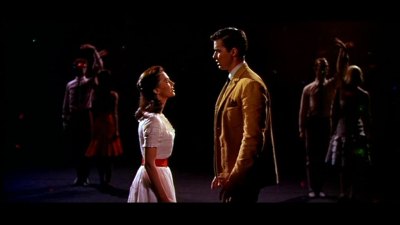
The DVD:
The Video:
The anamorphically enhanced, 2.20:1 widescreen image for West Side Story looks spectacular, with properly balanced colors and a razor-sharp image. I saw no compression artifacts.
The Audio:
The Dolby Digital English 5.1 Surround audio mix is equally impressive, with carefully separated channels and nicely modulated speaker action. There's a French and Spanish mono track, as well, along with close-captions. Subtitles in English, French and Spanish are also available.
The Extras:
The only extras included in this DVD of West Side Story is the option to view the film with the intermission intact.
Final Thoughts:
Still dazzling to look at and hear, West Side Story is nonetheless lopsided by the miscasting of Natalie Wood and Richard Beymer when viewed against the dynamism of terrific supporters George Chakiris, Rita Moreno and Russ Tamblyn.
A FUNNY THING HAPPENED ON THE WAY TO THE FORUM
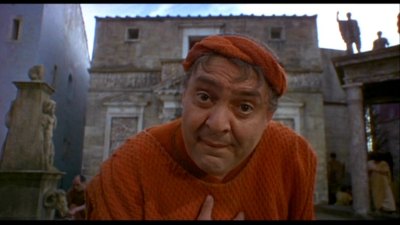
Based on the smash 1962 Broadway success with music and lyrics by Stephen Sondheim and a book by Burt Shevelove and Larry Gelbart (inspired by the Roman farces of ancient writer Plautus), A Funny Thing Happened on the Way to the Forum combines the play's burlesque sensibilities with the British New Wave techniques of director Richard Lester, creating a particularly funny, farcical romp that sports a beautifully maniacal comedic performance by that marvel, Zero Mostel.
Scheming, lying, gambling clown Pseudolus (Zero Mostel) wants only one thing in life (besides wine and women): his freedom. A slave to Senex (Michael Hordern) and Domina (Patricia Jessel), Pseudolus sees a chance to gain his liberty when his owners leave their son, dimwit Hero (Michael Crawford) in charge of the house while they travel. Hero, besotted with courtesan Philia (Annette Andre) who lives in the brothel next door, accepts Pseudolus' help in gaining Philia's affections, in exchange for Pseudolus' freedom. Unfortunately, Pseudolus is up against many obstacles, including the brothel's owner, Marcus Lycus (Phil Silvers), who has already promised Philia to raging egomaniac Captain Mile Gloriosus (Leon Greene), as well as Hysterium (Jack Gilford), the head slave at the house of Senex, and Pseudolus' nemesis. An ever-complex web of lies and deceptions follow, with hilarious results, as Pseudolus attempts to bring together Hero and Philia.
There were a few prominent critics of the day (Pauline Kael in particular) who distinctly disliked director Richard Lester's take on this burlesque paean to "lovers, liars and clowns" in ancient Rome. Lester, red-hot after helming the two influential Beatles' films A Hard Days' Night and Help!, as well as the well-received The Knack...And How to Get It (and who would soon direct what I think is one of the best cult films of the 1960s: Petulia), might seem like an odd choice to tackle this Borscht Belt celebration of fast-paced, wise-assed verbal humor.
But, as can happen when two distinct forms merge, the result is invigorating, with Lester's patently "chop and dice" method of unformed action perfectly setting a wild pace for the equally snarky, rim-shot back-and-forths of veteran Melvin Frank and Michael Pertwee's humorous screenplay. Lester's camera can't sit still for a moment, breaking up set pieces and musical numbers (most of the songs were thrown out for this film version) into a collage of images that perfectly matches the notion of farce. Frenzied action and frenzied characters meet a frenzied visual design that's a compliment to the intended tone, not a counterpoint. Lester, perhaps fully intending on making as anti-Hollywood an epic as he could, perfectly parodies not only the epic form (dirty, dingy, unimpressive sets, a ridiculously fake big action set-piece ending, with silly special effects), but also the 1960s musical, with crappy choreography and a determination to make sure everyone in the cast is seen to their worst advantage in lighting and framing.
Shot on a few of the rotting sets of producer Samuel Bronston's epic, The Fall of the Roman Empire, that still remained standing at his now-bankrupt Madrid, Spain film studio, A Funny Thing Happened on the Way to the Forum's grimy, mildewy look, with Lester's typically catch-as-catch-can lighting, effectively gets across the original intention of the play, which was to show the frequently funny, seamy, rutting low-comedy energy of a "less fashionable" district of Rome. While purists hate the fact that most of Sondheim's funny, intricate songs are missing (although original Broadway critics weren't all that pleased with Sondheim's score to begin with), Lester is clearly more interested in showing off the quick wits of his marvelous cast, as well as working in a very funny climax (again, disliked by a lot of film critics at the time) involving a slapstick chariot race that looks like a cross between the Keystone Kops and Benny Hill.
Of course none of this would work without that cast, and what a cast it is. Mostel, the originator of Pseudolus on Broadway, is hysterically funny in his seemingly endless array of facial expressions that convey lust, greed, envy, cringing fear, and above all, an acknowledged air of superiority over his "betters." It's a remarkable performance, full of unending energy (just watch how Mostel, in the opening credits singing the insanely catchy Comedy Tonight, immediately connects with the audience and promises them a good time when he sings right to them); it's a shame he couldn't have been on camera more often in his career. Equally impressive is the master, Phil Silvers, who can get more laughs out of a surprised reaction shot than just about any other comedian out there. Jack Gilford, with his menschy, warbling voice, had me laughing out loud when he promised to punish Pseudolus for his owner Domina ("I shall be brutal."); in Lester's parody of 1960s musical interlude montages, Gilford gets big laughs, dressed in drag, as the portly Mostel scampers after him in slow motion, among the flowers and trees. And out of the blue, expert British character actor Michael Hordern - not your first choice to play alongside these burlesque experts - more than holds his own as the henpecked Senex; his hangdog face, forever set on "cringe" when his harpy wife Domina slaps him down, is a source of constant amusement. With these old pros throwing around the one-liners, and director Lester chopping it all up and throwing it in the air with abandon, A Funny Thing Happened on the Way to the Forum winds up one of the liveliest, funniest musicals of the 1960s.
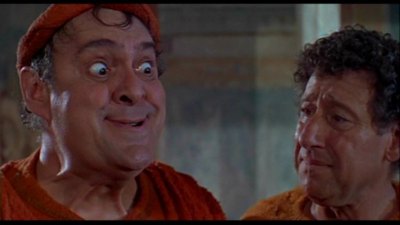
The DVD:
The Video:
Sporting a surprising clear, anamorphically enhanced 1.85:1 widescreen transfer, A Funny Thing Happened on the Way to the Forum looks better than any other time I've seen it. Colors, such as they are, are accurately reproduced, and the sharp picture reveals a lot of the detail of those wonderfully moldering sets.
The Audio:
The Dolby Digital 3.0 Surround audio mix is adequate, but unexciting. French and Spanish subtitles are available, as are close-captions.
The Extras:
There's an original trailer included for A Funny Thing Happened on the Way to the Forum .
Final Thoughts:
Gloriously low-brow and vulgar (although not explicit by any means), with director Richard Lester's wild and wooly visual style, A Funny Thing Happened on the Way to the Forum is burlesque bedroom farce at its best, with an astoundingly funny turn by Zero Mostel as the slave Pseudolus. Puerile, delightful sight gags abound, and Lester's determined effort to make a dirty, grimy, crappy anti-Hollywood epic is hilariously successful.
HOW TO SUCCEED IN BUSINESS WITHOUT REALLY TRYING
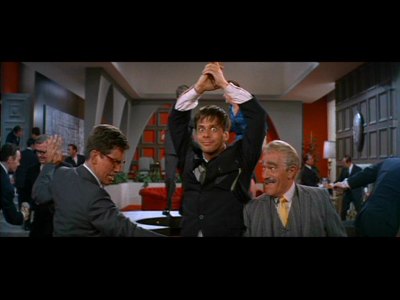
Winner of seven Tony Awards, including Best Musical, as well as the 1962 Pulitzer Prize for Drama, How to Succeed in Business Without Really Trying is the 1967 film version of the play (which was inspired by a same-titled funny spoof of "how to" books and corporate America by Shepherd Mead) which featured music and lyrics by Frank Loesser and a book by Abe Burrows, Jack Weinstock, and Willie Gilbert. Produced, written and directed by David Swift (Pollyanna, The Parent Trap), and starring Robert Morse (who originated the role on Broadway), How to Succeed in Business Without Really Trying affectionately spoofs corporate America; with its catchy songs and bright cast, it really could have been something had it found the right director.
Window washer J. Pierpont Finch (Robert Morse) picks up a self-help book entitled "How to Succeed in Business Without Really Trying," and following it religiously, manages to worm his way to the chairmanship of the board of World Wide Wickets Company...in one week's time. Through a constant campaign of brown-nosing combined with back-stabbing treachery (including using his sexy secretary, Hedy LaRue, played by Maureen Arthur, to topple various horny executives), Ponty ingratiates himself with scatterbrained, capricious president J. B. Biggley (Rudy Vallee), while knocking out of contention Biggley's whining, incompetent nephew, Bud Frump (Anthony Teague). But complications arise when Rosemary Pilkington (Michele Lee), Ponty's girlfriend and a secretary who has helped Ponty throughout his meteoric rise, discovers the extent of his deceitfulness
Muted by director David Swift's literalness, How to Succeed in Business Without Really Trying shows all the signs of having had the potential to be a knock-out farce, with a funny, always-timely topic (trust me: corporate America is exactly the same today as it is in this film), a terrific cast, and of course, those Frank Loesser songs. But while frequently amusing, How to Succeed in Business Without Really Trying doesn't really take off because Swift refuses to do anything but sit back and let the camera record an essentially staged production of the show. Sticking his actors squarely in the middle of the Panavision frame, set-up after set-up follows, with actors, usually in a mid-two-shot, going about their antics. Even when the few dance scenes (Bob Fosse's original work is kept here for the film version) show up, they're not translated into cinematic terms; this is a filmed play, and quite a bit of the intended energy is drained as a result.
Certainly the cast is game, with the sprightly little Robert Morse delightful as the unaffected, cool-as-a-cucumber window washer who grins his way through one unearned accomplishment after another. His character is really a subversive jerk, willing to sell out anybody to get to the top (the best line in the movie comes towards the end, when the narrator intones from Ponty's book that when things go wrong, rule number one is, "Put the blame on somebody else"), but Morse is such an endearing actor you're rooting for him to succeed. And creating nice chemistry with Morse is the talented Michele Lee, who's bright as a penny when she's singing the lovely I Believe in You. Veteran character actor (and former world-famous crooner) Rudy Vallee is a delight as the befuddled, bombastic boob, J.B. Biggley. Only Anthony Teague, in the crucial role as the patsy Bud Frump, fails to impress (I would imagine Charles Nelson Reilly, who won a Tony for his work as Frump in the original Broadway version, was a scream in the role).
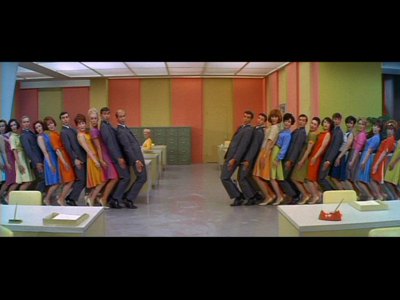
The DVD:
The Video:
Sporting a truly awful, flat, non-anamorphic 2.35:1 letterboxed transfer, How to Succeed in Business Without Really Trying looks terrible, with washed out colors and excessively heavy grain. You can tell that the some of the nicely designed 1960s office backdrops were colorful, but you have to guess at that with this soft, murky mess of a picture.
The Audio:
Further ruining the viewing experience of How to Succeed in Business Without Really Trying is the Dolby Digital English 1.0 mono audio track. The music is too good in this film to just get by on that kind of mix. Spanish and French subtitles are included, as are close-captions.
The Extras:
There's a trailer included for How to Succeed in Business Without Really Trying.
Final Thoughts:
What could have been a spirited, knock-about romp spoofing the business of corporate America, is only just amusing due to director David Swift's flat-footed treatment of the material. The cast is game, and the material is there (including some lovely Frank Loesser songs), but the presentation is square and unimaginative.
CHITTY CHITTY BANG BANG
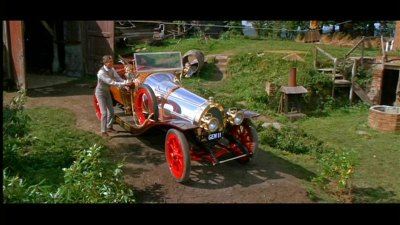
The lone musical in the MGM Classic Musicals Collections not based on a previous Broadway hit (although it would be later adapted into one), Chitty Chitty Bang Bang, based very, very loosely on the children's book by James Bond creator, Ian Fleming, has grown in popularity over the decades (after years of reruns and VHS and DVD releases) to the point where not many people remember its less-than-favorable critical reception. Expensive to make, Chitty Chitty Bang Bang pulled in a decent box office, but not nearly enough to recoup its costs, going down as a "flop" with both studio heads and the critics (although I would have to believe by now it's more than made back a profit - and then some). Children of my generation who saw it perhaps re-released a few years later at the drive-in, or during its numerous reruns on TV, love the film's fantasy-based storyline and the tuneful soundtrack. And seen today, it shows no signs of failing to appeal to new crops of young viewers (my own kids adore it).
Inventor Caractacus Potts (Dick Van Dyke), a widower with two small children Jemima and Jeremy (Heather Ripley and Adrian Hall), is having difficulty selling any of his wacky inventions. When the children ask him to purchase a junked-out former racing car, Chitty, to keep it from the scrap yard, Caractacus has to come up with a money-making idea. A previous experiment with candy yielded a pop that whistled - perfect for Lord Scrumptious' (James Robertson Justice) candy factory. And with Truly Scruptious' (Sally Ann Howes) prodding (the snooty, yet loving Truly met the Potts on a Sunday drive), Caractacus goes to the factory to sell the candy - with disastrous results (the high-pitched whistles drive dogs insane). After earning money at a county fair, singing with a traveling troupe, Caractacus finally has enough money to purchase Chitty, and he squirrels her away in the barn, working in secret to get her going.
Of course, Grandpa Potts (Lionel Jeffries), an eccentric who spends quite a bit of time "traveling" in his outhouse, doesn't believe that Caractacus can get the car running, but everyone is stunned when Caractacus wheels out the gleaming, beautifully restored (and slightly modified) Chitty. Taking the children and Truly for a picnic by the beach, Caractacus starts to spin a yarn about Baron Bomburst (Gert Frobe), who wants to steal Chitty, and who has imprisoned all the children of Vulgaria because he hates toys. Soon, the children, Truly and Caractacus find themselves characters in the story, with Chitty the flying car the real heroine of piece. But after all is said and done, was it really just a made-up story, after all?
Brought to the screen by Bond producer Albert Broccoli, Chitty Chitty Bang Bang has the glossy, expensive, big-screen look typical of one of the 007 opuses, as well as the same kind of fascination with gadgets and comic-book style action associated with the Fleming films. The production values are first rate (seriously, Chitty is a most remarkable film creation, far more interesting than any ride Bond had), and the score, by Mary Poppins songwriters Richard and Robert Sherman, is delightful. Although dismissed at the time of release, it's tough to find one song in the score that doesn't signal immediate recognition from even casual viewers of the film. Standouts including the lovely, haunting Hushabye Mountain; the hysterical Posh (Lionel Jeffries really sells that one); the raucous Me Ol' Bamboo (a spectacular production number, with Van Dyke at his finest); the Doll on a Music Box/Truly Scrumptious medley (with Van Dyke and Howes absolutely charming together), and of course, the icon theme song - seriously; who hasn't sung that at least once on a car trip?
And while critics at the time had difficulty with the dark tone of the final section of Chitty Chitty Bang Bang, I think it works quite well; it's rather like a true Grimm fairy tale, with the dark, disturbing images of children chained up below in a dungeon a welcome variation on the standard, safe "kiddie" shows that were coming out in the mid-to-late '60s. The "is it reality or is it a dream" structure of the story is compelling for a child (I can remember thinking, quite delightedly: "Is he still telling a story, or is this really happening?"), and the cast is spot-on, with Van Dyke more than living up to his song-and-dance reputation. Howes is dewy and blonder-than-blonde, with that sterling voice peeling out on her big solo number (Lovely Lonely Man), and Jeffries is an utter delight, providing the necessary grit (and a bit of bathroom humor) to his parody of a Raj-era military man. But perhaps most importantly, and an element rarely done correctly in these types of children's films, is the casting of the two child actors. Heather Ripley and Adrian Hall never come off as precocious snots or over-polished Hollywood pro child actors; they really seem like sweet, natural kids (no doubt due to director Ken Hughes' careful treatment of them), and they're quite effective in their sincerity.
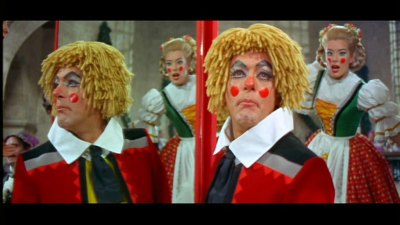
The DVD:
The Video:
The anamorphically enhanced, 2.35:1 widescreen video transfer for Chitty Chitty Bang Bang is the same transfer used in the special collector's edition that was released a few years ago. Colors are beautifully realized, and the picture is razor sharp. For some unknown reason, a full screen, pan-and-scanned version is available on the flip side of the disc, but why anyone would purposefully watch a film that way is anybody's guess.
The Audio:
There's a strong, varied Dolby Digital English 5.1 Surround track available, which offers quite a bit of rear level speaker action. As well, there's a French Stereo track, a Spanish 2.0 Stereo track, and a Portugese mono track. Subtitles are available in English, French, Spanish, and Portuguese. Close-captioning is also available.
The Extras:
A sing-along option is included here, but it's basically just the subtitle option.
Final Thoughts:
Indifferently received when first released late in 1968, Chitty Chitty Bang Bang has grown in popularity, becoming first a cult hit and now a mainstream classic. Terrific songs by the Sherman brothers, a first-class production from the makers of the James Bond films, and an energetic cast (with Dick Van Dyke excellent as always) make Chitty Chitty Bang Bang a very special musical.
FIDDLER ON THE ROOF
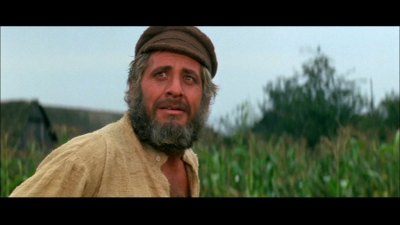
Based on the mammoth Broadway hit, with music by Jerry Bock, lyrics by Sheldon Harnick and a book by Joseph Stein, 1971's Fiddler on the Roof is transferred beautifully to the screen, with director Norman Jewison treating the material with taste and restraint, letting the strengths of the play - the songs, and the core appeal of the story, based on the tales written by Sholem Aleichem - move the long production along. Tevye (Topol), a dairyman for the small shtetl of Anatevka, lives a precarious life in Tsarist Russia, where Jews suffer persecution as a matter of government policy. Living with this constant undercurrent of nervous worry about what hardship will come next, Tevye also has to come to terms with a more universal problem: his daughters are growing up and away from him.
Keenly aware that his religion's strict traditions are the only ties that keep his people together, Tevye is buffeted by his three eldest daughters' rejection of those traditions. Eldest Tzeitel (Rosalind Harris) refuses Tevye's arranged marriage to wealthy butcher Lazar Wolf (Paul Mann) to marry poor tailor Motel (Leonard Frey); beautiful Hodel (Michele Marsh) eventually leaves the family and the village to be with her radical intellectual husband Perchik (Paul Michael Glaser), who has been imprisoned in Siberia; and little Chava (Neva Small) has married outside her religion to handsome Russian Orthodox Fydeka (Ray Lovelock). However devastating these changes are (particularly with Cheva, who Tevye disowns for her transgression), Tevye, with the love of his good wife Golde (Norma Crane) can withstand even the forced emmigration from his own land, because he still has faith in his traditions and in God.
Gorgeously filmed in Yugoslavia (cinematographer Oswald Morris' work here is masterful), the three-hour-long Fiddler on the Roof maintains such a modest, measured tone (except for a digression here and there; particularly Tevye's dream sequence), that it's quite unlike most big-scale musical blockbusters from that era. Spectacle is eschewed for naturalism (or as much naturalism as is possible in a musical), with the memorable songs presented in a simple, unaffected way. Jewison never overpowers the material (critically, his decision not to cast Broadway originator of Tevye, Zero Mostel, because he would have bowled over the material on screen, is key to this restraint). He recognizes the power inherent in the simple yet layered story, and in the touching, sometimes rousing score (The opening Tradition number is built expertly). While I've never thought that the Tevye's Dream sequence fits at all with the naturalistic tone that Jewison achieves (I suppose it was included because it's such a popular moment in the play), it's a momentary blip on Jewison's carefully crafted three hour opus.
Topol is simply marvelous as Tevye: watchful, resigned at times, and yet joyous when he understands that the cycles of life never go in the direction we mandate, and that a faith in God and observance in our cultural traditions can ease our difficulties and uncertainties. Glaser, soon to be a television icon of the '70s with Starsky and Hutch, is quietly authoritative as the intellectual rebel Perchik, and Frey does some amazing little bits of business as the tentative, scared, and ultimately strong Motel (although I have to admit it's hard to picture him as anyone other than Harold from The Boys in the Band). And the three actresses playing Tevye's older daughters, Harris, Marsh and Small, are a welcome respite from the polished, slick Hollywood starlets that the film studios no doubt would have cast had Fiddler on the Roof been made ten years earlier. Moving, wonderfully life-affirming, and expertly mounted, Fiddler on the Roof is one of the last of the truly great Hollywood musicals.

The DVD:
The Video:
The anamorphically enhanced, 2.35:1 widescreen video transfer for Fiddler on the Roof is beautifully controlled, with colors perfectly valued and no compression issues. The image is startlingly clear.
The Audio:
There's an equally good Dolby Digital English 5.1 Surround stereo mix (with most of the effects directed towards the front), as well as English, French and Spanish mono tracks. Subtitles in English and Spanish are available, as well as close-captions.
The Extras:
There's an audio commentary by director Norman Jewison that's quite informative about the production.
Final Thoughts:
Tastefully brought to the screen, director Norman Jewison lets the material dominate, with the resulting three hour musical achieving a depth of emotion quite rare in such stage-to-screen adaptations. The cast is uniformly excellent.
Final Thoughts on the Box Set:
The MGM Classic Musicals Collection is an attractively priced boxed set of six classic American musicals. There's no need to double dip if you already have these films, but if you're looking for a cheaper way of obtaining some of these classic titles, minus the bonus features of special editions (with the exception of Guys and Dolls and How to Succeed in Business Without Really Trying, both of which sport terrible, flat non-anamorphic transfers), you can't go wrong with the MGM Classic Musicals Collection. For the money, not a bad collection at all. I recommend MGM Classic Musicals Collection.
Paul Mavis is an internationally published film and television historian, a member of the Online Film Critics Society, and the author of The Espionage Filmography.


|
| Popular Reviews |
| Sponsored Links |
|
|
| Sponsored Links |
|
|
| Release List | Reviews | Shop | Newsletter | Forum | DVD Giveaways | Blu-Ray | Advertise |
|
Copyright 2024 DVDTalk.com All Rights Reserved. Legal Info, Privacy Policy, Terms of Use,
Manage Preferences,
Your Privacy Choices | |||||||









